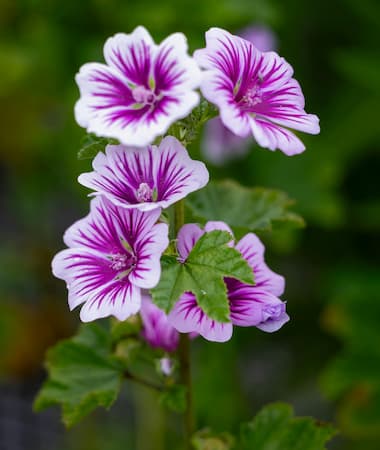How to Grow Mallow Flowers

About Growing Mallow Plants in Your Home Flower Garden
Mallow is a fun and easy-to-grow member of the Hibiscus plant family. While today this plant calls many places “Home”, it is native to North America, Asia, and Australia. depending upon your point of view, mallow is a weed, a flower, or an edible plant. If you are growing mallow flowers, you can also harvest the edible mallow leaves to use in salads, soups, and stews.
there are annual and perennial varieties of Mallow plants. But, they are most often grown as an annual plant.
The flower blooms resemble hollyhocks, and are 2 inches across, in pink or white colors. The leaves are heart-shaped. Large leaves at the bottom of the plant, gradually give way to smaller leaves, higher up the stem.
Mallow flowers attract butterflies.
Try growing Mallow in flower beds, borders, or containers on your patio or deck.
Mallow looks good in cut flower arrangements. too.
Mallow Plant Specifications
Flower Colors: Blooms include orange, pink, purple, red, yellow, and white.
Flowers Bloom: Summer and Fall.
Plant Height: One to four feet tall, depending upon variety.
Ideal Soil pH: 6.0 – 7.0
Light Requirement: Full sun.
Hardiness Zones: 2 – 11
Are Plants Toxic? No.
Deer Resistant? Yes. It is deer and rabbit resistant.
Number of Species: Over 4,000 species.
Native To: Asia, Europe, and North Africa.
Plant Type: Annuals and Perennials
Botanical Name: Lavatera trimestris
Other Names: French Hollyhock, Malva, Striped Mallow
Are Mallow Plants Edible?
YES!!
All parts of Mallow plants are edible. Eat them raw or cooked.
Use the leaves in salads as greens. Or cook them in soups and a variety of recipes. Mallow flowers and bud can be pickled or cooked in recipes. The seeds are often used a a snack. Try them in trail mix.
Medicinal Applications for Mallow Plants
Mallow flowers are used in a variety of home herbal medicines.
Among them are:
- Use it to treat inflammation in the digestive, respiratory, and urinary systems.
- It helps to ease asthma, bronchitis, and coughs.
- Use it to sooth sore throats.
- It eases toothaches.
- Relieve constipation.
Light Requirements
Grow Mallow flowers in bright, direct sunlight. Select a planting location where they will receive at least seven to eight hours of sunlight. In hotter regions of the country, grow them where they are partially shaded from the hot afternoon sun.
Mallow Plant Propagation
Mallow plants are grown from seeds. Sow seeds directly into your flower garden after all danger of frost has passed.
While you can start seeds, indoors, they do not like to be transplanted. If you choose an indoor start, we recommend using peat pots. Transplant before roots begin to emerge through the pot.
Mallow can also be propagated by rooting cuttings. Use tender, young stems.
Ideal Germination Temperature: 70 degrees
Days to Germination: 5 – 10 days.
Plant Spacing: 32 inches to three feet, depending upon variety.
How to Grow Mallow Flower Plants
Grow Mallow plants in full sun. They will tolerate partial shade.
Mallow plants like good to average soils, that are well-drained. Add a generous amount of compost into the soil before planting.
The plants are drought-tolerant but grow best with a constant supply of water.
Water regularly extended during droughts.
Apply a general-purpose fertilizer monthly.
Established Mallow plants are low maintenance. For a bushier growth, pinch back growing tips after the plant reaches 12″.
Add mulch around the plants for appearance, and to keep weeds down.
Deadhead spent flowers, to promote new blooms.
Growing Mallow Flowers in Containers
Mallow plants are not commonly grown in containers and flowerpots. However, shorter varieties may look good in containers in some settings. In addition to the normal steps for growing them, here’s how to care for them in a flowerpot:
- It is important to have a drain hole to allow excess water to drain from the pot.
- Keep an eye on the moisture level. Check the plants every day or two, especially in extended periods of hot, dry weather.
- Keep the soil moist, but not wet. It is okay to let the top of the soil begin to dry between watering.
- When watering the plants, thoroughly wet the soil. Excess water will drain through the hole in the bottom of the flowerpot.
- Nutrients in a flowerpot are limited. So, use fertilizer spikes to feed the plants. Or, apply a light solution of liquid fertilizer once a month.
- Select a sunny to partly sunny location on your deck.
Insects and Plant Disease
Perennial Achillea is resistant to insects and disease. If insect or disease problems occur, treat early with organic or chemical insect repellents and fungicide.
How to Overwinter Mallow Flowers
Annual varieties will die off after the first frost in your area.
Perennial varieties do not require any special winter protection.
Related Articles
Also, people who read this article will like:
Plant Problems – Identify the causes and find the cures.
Please support our site. Shop for:
- rmmatthews100@hotmail.com
- 585-721-6528
- Rochester, NY
©1999-2024 GardenersNet.Com, All Rights Reserved

